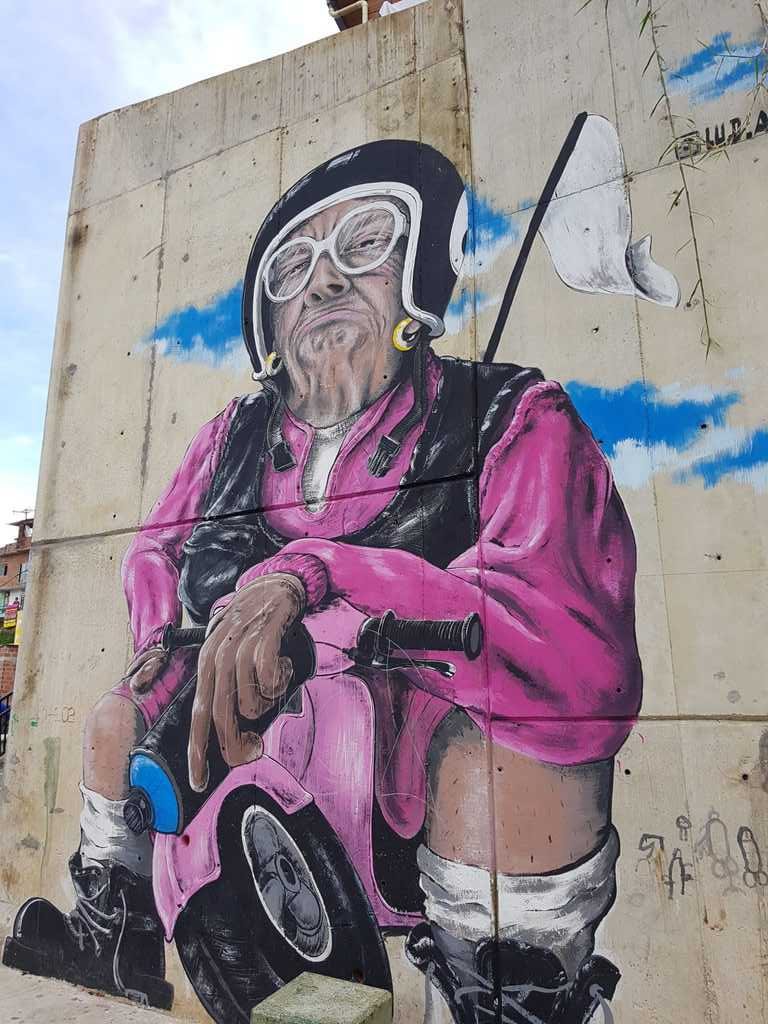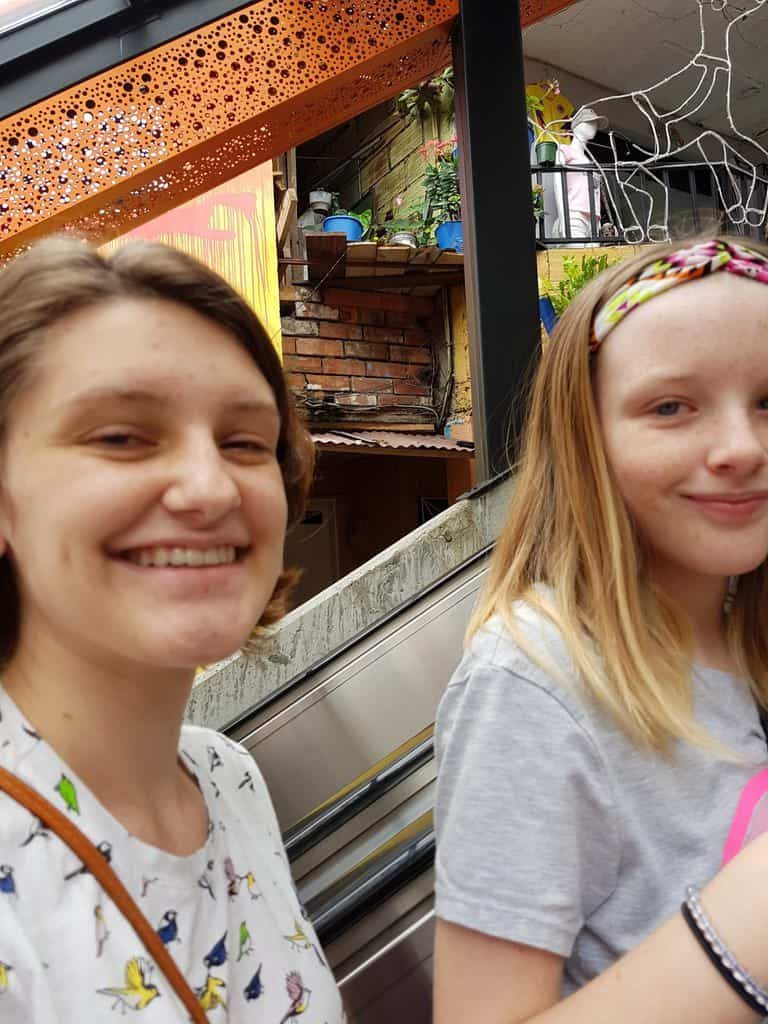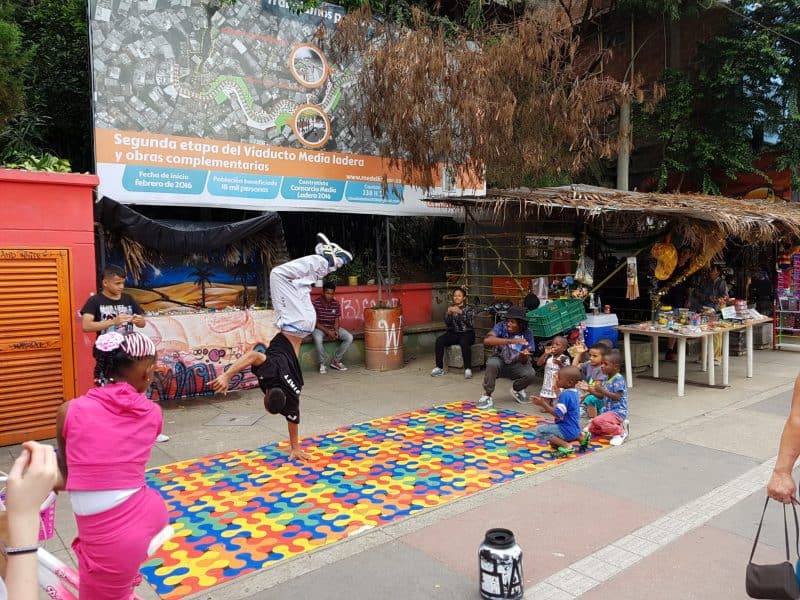There’s a lot to do in Medellin. The Colombian people have really figured out how to deal with all these pesky tourists who keep showing up. Unlike Panama, where tourists still seemed to be a rare breed, to be questioned and eventually dealt with begrudgingly (gross over-generalization of course), Colombians seem to use their natural warmth towards others and apply it to an entrepreneurial spirit. This ends up with lots of interesting opportunities for visitors to learn more about the city.
Comuna 13
A few weeks ago we did another tour of another neighborhood in Medellin. This area is known as Comuna 13 and they have a different set of challenges, and ways of dealing with them. This tour was free, which is a very good price. However that also means that you have to adjust your expectations for what you’ll get.
One of the educational elements our kids are learning is how to be a good tour guide. In addition, Dan and I are taking notes on how to be good Airbnb hosts. When we are done with this travelling journey thing we will be rockstars at tourism. For example, Haley says that when she is a tour guide she will not lead a group of 30 people down the street at a breakneck pace, pointing things out as she goes but only being heard by the first 5 people in the group because the rest of the group is practically sprinting to keep up with her. She will also find a spot where there is more than one bathroom, because when you have 10 ladies who need to use the loo, well, the tour runs behind schedule. She will also find a different way to explain 50 years of history while standing on the street corner with taxis zooming by. It’s a good thing we watched Narcos because we knew most of it already. Because, you know, Narcos is 1000% accurate with history, I am sure of it. #reallynotreally

Here’s the gist on Comuna 13. This is another area of town where the houses were built haphazardly on the hillside. This means they were far from commerce and jobs, and accessible only by the stairs. A LOT of stairs. Difficulty coming and going meant more barriers to getting jobs. No jobs meant people were very susceptible to working for the cartels, who would show up with plenty of money, offering easy jobs of spying or protecting the cartels. Don Berna, the heir to the drug throne following Escobar’s death, was well known in this area for putting unemployed people to work, unfortunately not in the most legal of ways. Fun fact: all throughout the tour our guide would not name Pablo Escobar’s name. It was a bit like “he who shall not be named” in Harry Potter. Don Berna got better treatment because at least his name was spoken. This is the first Colombian (our tour guide) who would not speak about Escobar. I think others have become accustomed to tourists’ fascination with him and have given up trying to pretend he did not exist.
I’ll tell you a little more about Comuna 13 while quoting another blog that I found particularly interesting and well-researched (jealous much, Allison!?).
One particular area of Medellín, an area called Comuna 13, also known as the San Javier, has the most tumultuous history of the city, once labeled the most dangerous community due to its astronomical homicide rates and forced displacement of thousands of residents.
Comuna 13 is an over-populated and low socio-economic zone that crawls up along the west hills of the city with thousands of brick and cement homes stacked close to one another. It was a pivotal center for paramilitary, guerrilla, and gang activity. Its location is ideal for crime, as it leads directly to the main highway (San Juan Highway), providing easy transportation of guns, drugs, and money.
Here is a brief timeline of the history of this area. This blogger chick is way better than I am at synthesizing information. Perhaps she didn’t have to wait in the line for the bathroom.
The 1980s-’90s: The neighborhood was controlled by groups loyal to Pablo Escobar, the notorious drug lord who lived in Medellín. Illegal activities remained rampant after his death in 1993, as drug cartels sought control of the area.
2002: One of the most pivotal events was on Oct. 16, 2002, when the Colombian military carried out the controversial Operation Orión, a strike to overthrow all rebel groups in Comuna 13. Over 1,000 policemen, soldiers, and aircrew in helicopters attacked the area (comprising of roughly 100,000 inhabitants). Nine people were killed (three children), and hundreds were wounded. The siege made it impossible to seek medical attention for the wounded, and the community took to the streets in solidarity flying white rags. With that action, the fighting stopped.
Post-2002: Residents voiced their discontent and anger with the violence that occurred in 2002 through art and community events. Striking street art around the neighborhood depicts scenes with the white rags raised for peace and solidarity.
Today: Residents are no longer afraid to leave their homes and their quality of life has changed positively. As we walked through the narrow roadways, kids were playing soccer in the streets, vendors were selling fruit and empanadas, and we laughed with friendly shopkeepers who let us sample their signature green mango ice cream topped with lime and salt. We felt comfortable visiting the area. However, a full transformation of this neighborhood will be slow and gradual, spanning decades. The situation is still tenuous and there’s still work to be done.
Art
One of the first things you notice about Comuna 13 is all the graffiti on the walls. There are a lot of walls (hills need propping up when you build on them!) and some residents took to the street with their art. This became well respected activity, with some unwritten rules, such as “thou shalt not cover up another person’s art without their permission”. Most of the graffiti is representative of the struggle the neighborhood has gone through, or some common theme like love or peace. Each one had a different meaning. It was a bit like a museum.
My new best friend blogger chick says: Art saved the city as a vehicle for creative and political expression. The walls became a canvas to tell its history, beautifying the area and bringing optimism and peace of the residents, children, and visitors.
Yeah, what she said… which is way more eloquent than my words.




Access (aka escalators)
The second star of the show in Comuna 13 was the escalators. Just like in La Sierra, addressing the needs of the neighborhood and reviving it from it’s drug and cartel-ridden activities means you’ve got to make it easy to come and go – especially to get to work. Cable cars were not a solution in this area but they did discover that escalators will work quite nicely and will cut the travel time down from 35 minutes to just 6 minutes.


This is not the first time in the world that escalators have been used for accessibility purposes. In Hong Kong they have also addressed the needs in this way. In addition to providing transportation, the escalators provide somewhat of a central point for vendors. As you travel up the hill and come off one escalator and move to another, there are vendors who are available to meet whatever need you might have, including a need for freshly cooked potato chips. That is a constant need.

The escalators were well maintained with plenty of security at the top and bottom. At the top where the escalator terminated there was a station that looked a lot like bus stations. It included a desk for information, bathrooms and even a classroom area that could be used for art, classes or meetings. It really seemed to be a central focus for the area. When we were there some guys were making giant paper lanterns to let off on New Year’s Eve (just like in Thailand!).







The views from the top of the neighborhood were excellent. But we could still go higher if we had chosen to use the stairs. Just like in La Sierra, it would be easy to get lost, the walkways are curvy and twisty and once you get off the main thoroughfare you just lose yourself among the houses.
Our guide, who lives in the neighborhood at the top of the last escalator, reports that the houses are in pretty good shape, they all have stable electricity and water. They have no heat nor A/C which is mostly not needed, although this area of town can become more chilly than the lower elevations.







Despite the organizational shortcomings, we enjoyed the tour very much and were happy to tip our guide to thank her for all her hard work. We enjoyed our escalator ride down, down, down to the central part of this area of Medellin. #really
